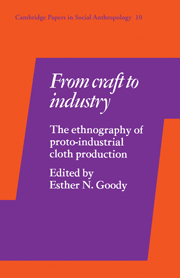Book contents
- Frontmatter
- Contents
- List of figures, maps and illustrations
- List of tables
- Notes on contributors
- 1 Introduction
- 2 On commoditization
- 3 Daboya weavers: relations of production, dependence and reciprocity
- 4 The tailors of Kano City
- 5 Production and control in the Indian garment export industry
- 6 Harris Tweed: construction, retention and representation of a cottage industry
- Notes
- References
5 - Production and control in the Indian garment export industry
Published online by Cambridge University Press: 04 August 2010
- Frontmatter
- Contents
- List of figures, maps and illustrations
- List of tables
- Notes on contributors
- 1 Introduction
- 2 On commoditization
- 3 Daboya weavers: relations of production, dependence and reciprocity
- 4 The tailors of Kano City
- 5 Production and control in the Indian garment export industry
- 6 Harris Tweed: construction, retention and representation of a cottage industry
- Notes
- References
Summary
INTRODUCTION
In the early summer of 1979 one of India's large and successful garment manufacturing and exporting companies closed down its modern factory on Bombay's Worli district seafront. This company, Paville Fashions Pvt. Ltd, which had grown from a thirty-machine operation in 1967 to an operation which at the height of its production in 1976 exported 35,746,644 rupees’ worth of goods, in January 1977 was producing over 100,000 garments a month and in the mid-1970's won a series of export awards. Despite this success, in 1979 it became impracticable to continue large-scale manufacturing.
The closure was not quite as dramatic as at first it seemed. In fact the company was changing its production strategy. Instead of depending on a large-scale unit for all its production, it turned to another system and started to subcontract much of its work to smaller units.
Throughout its short history the Indian garment export industry has been closely connected with the handloom industry. Even manufacturers with large-scale garment factories have depended on supplies of handloom cloth from an industry which continues to depend on various putting-out and subcontracting systems. To the historian of the handloom export trade, Paville's story would strike a familiar chord. During the history of the handloom cloth industry there have been various attempts to centralize production, and to replace a system of indirect control with one of direct control. But there too large-scale centralized production has rarely proved to be economical or practicable from the point of view of the capitalist merchants.
- Type
- Chapter
- Information
- From Craft to IndustryThe Ethnography of Proto-Industrial Cloth Production, pp. 133 - 165Publisher: Cambridge University PressPrint publication year: 1982
- 2
- Cited by



